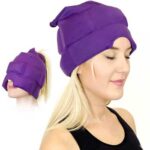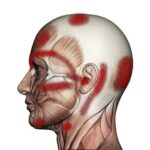The occipitalis is part of the occipitofrontalis, two muscles of the head. The occipitalis lies above the base of the skull, and the frontalis is the forehead muscle. The muscles are connected by a large swath of connective tissue, the epicranial aponeurosis.
Where is the occipitalis muscle?

The occipitalis attaches to the occipital bone in the back of the skull and connects to the epicranial aponeurosis, the connective tissue covering much of the skull.
What movements does the occipitalis muscle control?
- Pulls the scalp back
- Assists with raising the eyebrows
occipitalis muscle Pain

The symptoms:
- Pain in the back of the head and toward the top of the head.
- Pain around the eye
- Tight scalp
NOTE: Pain in the back and top of the head with shooting pain or aching in the eye are also signs of an aneurysm or cerebral hemorrhage. If you are experiencing these signs, it is important to see your doctor!
The occipitalis can contribute to wide-ranging pain throughout the head. A common complaint is an aching pain in the back of the head. Pain toward the top of the head that feels deep in the head is another common symptom.
Pain around the eye is often traced back to the occipitalis muscle. Occasionally there is a band of pain from around the eye that extends to behind the ear.
Another common sensation is that the scalp is pulled tightly over the skull.
The Causes of Occipitalis Pain
The most significant contributor to pain in the occipital muscle is stress and tension. When stressed, you exaggerate facial expressions like opening the eyes wide, squinting, and wrinkling the forehead, which works and overworks the muscle.
Eye strain affects both the occipital and frontalis muscles. Straining to focus the eyes puts constant stress on both of the muscles.
Constant strain on the occipitalis leads to the development of trigger points. Trigger points are small hard knots or bands in the muscle. Once trigger points develop, you must deactivate them to reduce and eliminate your pain.
Advertisement

Occipital Trigger Point Treatment
Treating occipital trigger points is easy. Place your fingertips above the base of the skull and rub up in the direction of the muscle fibers. If you feel a small knot, tight band of tissue, or an exceptional tender spot, stop and apply pressure for 10 seconds. Do not hold pressure longer as this will aggravate and inflame the tissue. Do this treatment 3-4 times a day until the knot, and the pain is gone.
TWD Recommended Products For Occipitalis Pain
 The Craniocradle treats headaches and stiff necks and is very effective for occipitalis muscle treatment. The cradle applies pressure to the muscles while providing gentle traction to the neck. Use for 5-10 minutes and feel a reduction in pain and stress. You can use the cradle to treat other body areas, including the low back and hip areas. An instruction manual with helpful tips is included.
The Craniocradle treats headaches and stiff necks and is very effective for occipitalis muscle treatment. The cradle applies pressure to the muscles while providing gentle traction to the neck. Use for 5-10 minutes and feel a reduction in pain and stress. You can use the cradle to treat other body areas, including the low back and hip areas. An instruction manual with helpful tips is included.
 I often recommend the Neck King Massage Tool For Neck and Back to my clients who suffer from headaches, migraines, and stiff necks. The Neck King works on trigger points and pressure points to help relieve muscle tension and pain. The secret to using the Neck King is to follow the directions carefully and slowly build up the time you use the tool. For many first-time users, the Neck King is too hard to use comfortably. Folding a hand towel and laying it over the Neck King will help ease the discomfort. It works exceptionally well on the muscles at the base of the skull. This tool has helped me and many of my clients relieve headaches, sore, stiff necks, and upper back strain.
I often recommend the Neck King Massage Tool For Neck and Back to my clients who suffer from headaches, migraines, and stiff necks. The Neck King works on trigger points and pressure points to help relieve muscle tension and pain. The secret to using the Neck King is to follow the directions carefully and slowly build up the time you use the tool. For many first-time users, the Neck King is too hard to use comfortably. Folding a hand towel and laying it over the Neck King will help ease the discomfort. It works exceptionally well on the muscles at the base of the skull. This tool has helped me and many of my clients relieve headaches, sore, stiff necks, and upper back strain.
 If you suffer from headaches, sinus pain, TMJ, or chronic jaw pain, the Headache Hat will help relieve your pain. The hat has two layers of cooling compartments that encircle the head, providing the recommended cold therapy and compression. It can be pulled down over the face to treat sinus and jaw pain. Highly recommended to people who find cold therapy better relieves their pain.
If you suffer from headaches, sinus pain, TMJ, or chronic jaw pain, the Headache Hat will help relieve your pain. The hat has two layers of cooling compartments that encircle the head, providing the recommended cold therapy and compression. It can be pulled down over the face to treat sinus and jaw pain. Highly recommended to people who find cold therapy better relieves their pain.
Interesting Facts About The Occipital Muscle
For those who have this talent, the occipitalis is the muscle that wiggles the ears.
Clinical diagnoses to which the occipital muscle symptoms may contribute:
- Tension headaches
- Migraines headaches
- Cluster headaches
- C2 radiculopathy
- Temporomandibular Joint Dysfunction
- Eye strain
Other muscles that should be considered and examined in conjunction with the occipital:
Satellite trigger points associated with the occipital muscle:
Find additional muscles that may contribute to these symptoms:
The occipital muscles can be affected and contribute to the conditions listed. We have listed other muscles that also contribute to these conditions.




